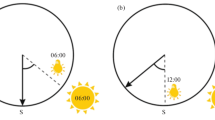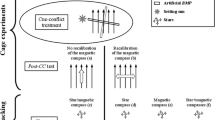Abstract
Migratory birds use compass systems derived from the geomagnetic field, the stars, the sun and polarized light patterns. We tested whether birds use a single underlying reference system for calibration of these compasses and, specifically, whether sunset and sunrise polarized light cues from the region of the sky near the horizon are used to calibrate the magnetic compass. We carried out orientation experiments with Savannah sparrows, Passerculus sandwichensis, in Alaska during autumn migration 2005, and compared the magnetic orientations of individual birds before and after exposure to conflicting information between magnetic and celestial cues. Birds exposed to an artificially shifted polarization pattern (±90° shift relative to the natural condition) for 1 h at local sunrise or sunset recalibrated their magnetic compass, but only when given access to the artificial polarization pattern near the horizon. Birds exposed to a 90° clockwise-shifted magnetic field for 1 h at solar noon did not recalibrate their magnetic compass. These results indicate that migratory birds calibrate their magnetic compass using the skylight polarization pattern vertically intersecting the horizon at sunrise and sunset. In conjunction with earlier work showing that sun and star compass calibrations are secondarily derived from magnetic and polarized light cues, our findings suggest that polarized light cues near the horizon at sunrise and sunset provide the primary calibration reference for the compass systems of migratory songbirds.




Similar content being viewed by others
References
Able KP (1982) Skylight polarization patterns at dusk influence migratory orientation in birds. Nature 299:550–551
Able KP (1993) Orientation cues used by migratory birds: a review of cue-conflict experiments. TREE 8:367–371
Able KP, Able MA (1990a) Calibration of the magnetic compass of a migratory bird by celestial rotation. Nature 347:378–380
Able KP, Able MA (1990b) Ontogeny of migratory orientation in the Savannah sparrow, Passerculus sandwichensis: calibration of the magnetic compass. Anim Behav 39:905–913
Able KP, Able MA (1993) Daytime calibration of magnetic orientation in a migratory bird requires a view of skylight polarization. Nature 364:523–525
Able KP, Able MA (1995a) Interactions in the flexible orientation system of a migratory bird. Nature 375:230–232
Able KP, Able MA (1995b) Manipulations of polarized skylight calibrate magnetic orientation in a migratory bird. J Comp Physiol A 177:351–356
Able KP, Able MA (1997) Development of sunset orientation cues in a migratory bird: no calibration by the magnetic field. Anim Behav 53:363–368
Åkesson S (1994) Comparative orientation experiments with different species of passerine long-distance migrants: effect of magnetic field manipulation. Anim Behav 48:1379–1393
Åkesson S, Hedenström A (2007) How migrants get there: migratory performance and orientation. BioScience 57:123–133
Åkesson S, Morin J, Muheim R, Ottosson U (2002) Avian orientation: effects of cue-conflict experiments with young migratory songbirds in the high Arctic. Anim Behav 64:469–475
Alerstam T (2001) Detours in bird migration. J Theor Biol 209:319–331
Alerstam T, Gudmundsson GA (1999) Bird orientation at high latitudes: flight routes between Siberia and North America across the Arctic Ocean. Proc R Soc Lond B 266:2499–2505
Alerstam T, Gudmundsson GA, Green M, Hedenström A (2001) Migration along orthodromic sun compass routes by arctic birds. Science 291:300–303
Alerstam T, Hedenström A, Åkesson S (2003) Long-distance migration: evolution and determinants. Oikos 103:247–260
Batschelet E (1981) Circular statistics in biology. Academic, London
Beason RC (1987) Interaction of visual and non-visual cues during migratory orientation by the bobolink, Dolichonyx oryzivorus. J Ornithol 128:317–324
Bingman VP (1983) Magnetic field orientation of migratory Savannah sparrows with different first summer experience. Behaviour 87:43–51
Bingman VP (1984) Night sky orientation of migratory pied flycatchers raised in different magnetic fields. Behav Ecol Sociobiol 15:77–80
Bingman VP, Wiltschko W (1988) Orientation of dunnocks, Prunella modularis, at sunset. Ethology 77:1–9
Bingman VP, Budzynski CA, Voggenhuber A (2003) Migratory systems as adaptive responses to spatial and temporal variability in orientation stimuli. In: Berthold P, Gwinner E, Sonnenschein E (eds) Avian migration. Springer, Berlin, pp 567–469
Cochran WW, Mouritsen H, Wikelski M (2004) Migrating songbirds recalibrate their magnetic compass daily from twilight cues. Science 304:405–408
Emlen ST (1970) Celestial rotation: its importance in the development of migratory orientation. Science 170:1198–1201
Hegedüs R, Åkesson S, Wehner R, Horváth G (2007a) Could Vikings have navigated under foggy and cloudy conditions by skylight polarization? On the atmospheric optical prerequisites of polarimetric Viking navigation under foggy and cloudy skies. Proc R Soc Lond A 463:1081–1095
Hegedüs R, Åkesson S, Horváth G (2007b) Polarization of overcast skies and implications for animal orientation: radiative transfer of the clear-sky E-vector pattern through thick ice and water clouds. J Opt Soc Am A (in press)
Moore FR (1987) Sunset and the orientation behaviour of migrating birds. Biol Rev 62:65–86
Mouritsen H (1998) Redstarts, Phoenicurus phoenicurus, can orient in a true-zero magnetic field. Anim Behav 55:1311–1324
Mouritsen H, Larsen ON (1998) Evaluating alternative methods for the analysis of Emlen funnel data. In: Mouritsen H (ed) Compasses and orientational strategies of night migrating passerine birds. Center of Sound Communication, Institute of Biology, Odense University, Odense, pp 115–124
Muheim R, Åkesson S, Alerstam T (2003) Compass orientation and possible migration routes of passerine birds at high arctic latitudes. Oikos 103:341–349
Muheim R, Moore FR, Phillips JB (2006a) Calibration of magnetic and celestial compass cues in migratory birds––a review of cue-conflict experiments. J Exp Biol 209:2–17
Muheim R, Phillips JB, Åkesson S (2006b) Polarized light cues underlie compass calibration in migratory songbirds. Science 313:837–839
Munro U, Wiltschko R (1995) The role of skylight polarization in the orientation of a day-migrating bird species. J Comp Physiol A 177:357–362
Phillips JB, Moore FR (1992) Calibration of the sun compass by sunset polarized light patterns in a migratory bird. Behav Ecol Sociobiol 31:189–193
Phillips JB, Waldvogel JA (1988) Celestial polarized patterns as a calibration reference for sun compass of homing pigeons. J Theor Biol 131:55–67
Prinz K, Wiltschko W (1992) Migratory orientation of pied flycatchers: interaction of stellar and magnetic information during ontogeny. Anim Behav 44:539–545
Pyle P, Howell SNG, Yunick RP, DeSante DF (1987) Identification guide to North American passerines. Slate Creek, Bolinas, CA
Schmidt-Koenig K (1990) The sun compass. Experientia 46:336–342
Weindler P, Liepa V (1999) The influence of premigratory experience on the migratory orientation of birds. In: Adams NJ, Slotow RH (eds) Proceedings of the 22nd International Ornithological Congress. Birdlife South Africa, Johannesburg, South Africa, pp 979–987
Weindler P, Wiltschko R, Wiltschko W (1996) Magnetic information affects the stellar orientation of young bird migrants. Nature 383:158–160
Weindler P, Baumetz M, Wiltschko W (1997) The direction of celestial rotation influences the development of stellar orientation in young garden warblers, Sylvia borin. J Exp Biol 200:2107–2113
Weindler P, Liepa V, Wiltschko W (1998) The direction of celestial rotation affects the development of migratory orientation in pied flycatcher, Ficedula hypoleuca. Ethology 104:905–915
Wiltschko W, Wiltschko R (1976) Interrelation of magnetic compass and star orientation in night-migrating birds. J Comp Physiol A 109:91–99
Wiltschko R, Wiltschko W (1995) Magnetic orientation in animals. Springer, Berlin
Wiltschko R, Wiltschko W (1999) Celestial and magnetic cues in experimental conflict. In: Adams NJ, Slotow RH (eds) Proceedings of the 22nd International Ornithological Congress. Birdlife South Africa, Johannesburg, South Africa, pp 988–1004
Wiltschko R, Wiltschko W, Munro U (1997) Migratory orientation in birds: the effects and after-effects of exposure to conflicting celestial and magnetic cues. In: Orientation and navigation––birds, humans and other animals. Royal Institute of Navigation, Oxford, pp 6.1–6.14
Wiltschko W, Weindler P, Wiltschko R (1998) Interaction of magnetic and celestial cues in the migratory orientation of passerines. J Avian Biol 29:606–617
Acknowledgments
We thank the Swedish Polar Research Secretariat, Brian J. McCaffery, Mike Rearden and the staff at the US Fish and Wildlife Service, Yukon Delta National Wildlife Refuge, for financial and logistic support. We are grateful to Thomas Alerstam for valuable comments on the manuscript. This work was financed by the Swedish Science Research Council and the Swedish Polar Research Secretariat (to SÅ). RM was funded by the Swiss National Science Foundation (postdoctoral fellowship) and JBP by the US National Science Foundation (IBN04–25712 and IBN02–16957). All experiments were approved by the US Fish and Wildlife Service (permit #05-YDNWR-02).
Author information
Authors and Affiliations
Corresponding author
Additional information
Communicated by H. Mouritsen.
Rights and permissions
About this article
Cite this article
Muheim, R., Åkesson, S. & Phillips, J.B. Magnetic compass of migratory Savannah sparrows is calibrated by skylight polarization at sunrise and sunset. J Ornithol 148 (Suppl 2), 485–494 (2007). https://doi.org/10.1007/s10336-007-0187-4
Received:
Revised:
Accepted:
Published:
Issue Date:
DOI: https://doi.org/10.1007/s10336-007-0187-4




